Abstract
The influence of miconazole on polymorphonuclear leukocytes (PMN) was investigated and compared with that of amphotericin B (AmB). Human PMN were preincubated in vitro with miconazole or AmB at therapeutically attainable concentrations in plasma, and their chemotactic functions were assessed with the synthetic chemotactic peptide N-formylmethionyl-leucyl-phenylalanine (FMLP). Changes in membrane fluidity of PMN were examined by an excimer-forming lipid technique. Adherence of PMN was measured by a nylon fiber column method. Miconazole and AmB pretreatment irreversibly depressed PMN random migration and chemotaxis under agarose but did not influence superoxide anion production. Both miconazole and AmB increased PMN adherence. Miconazole and AmB lowered the binding affinity of FMLP receptors on PMN and decreased the membrane fluidity in a similar manner. These results demonstrate that miconazole and AmB alter selected in vitro membrane properties of human PMN.
Full text
PDF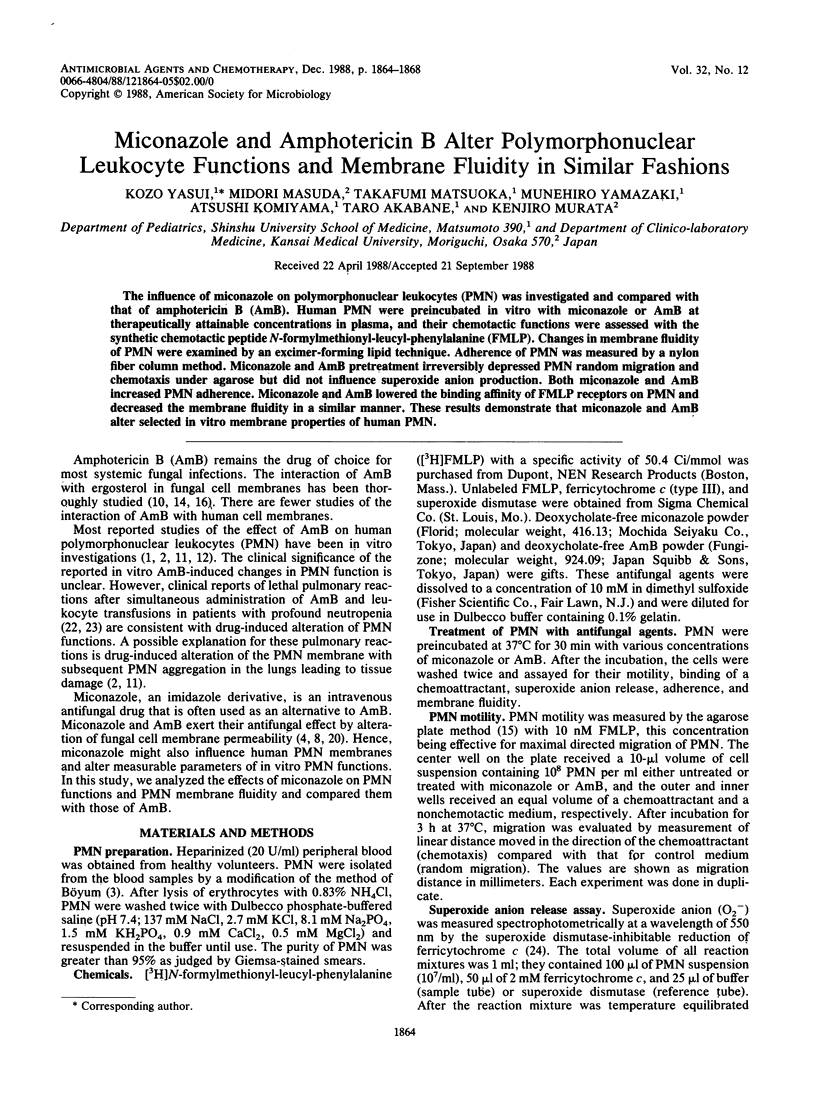
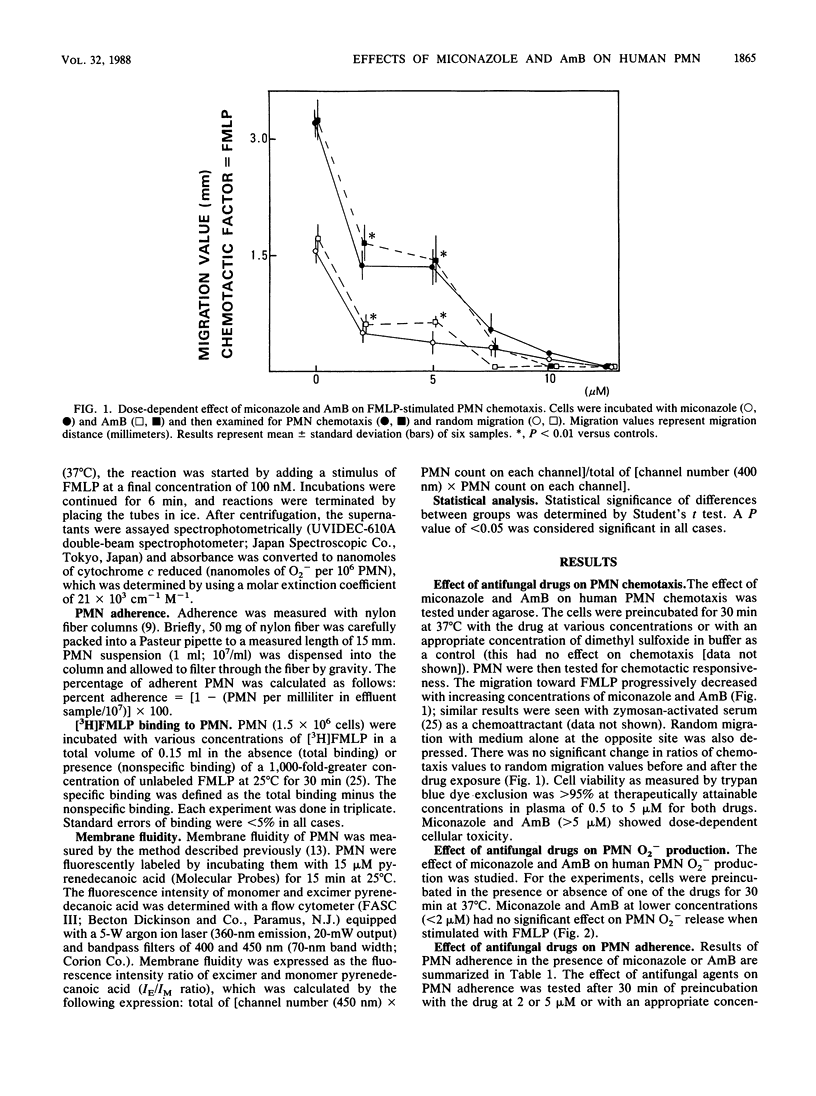
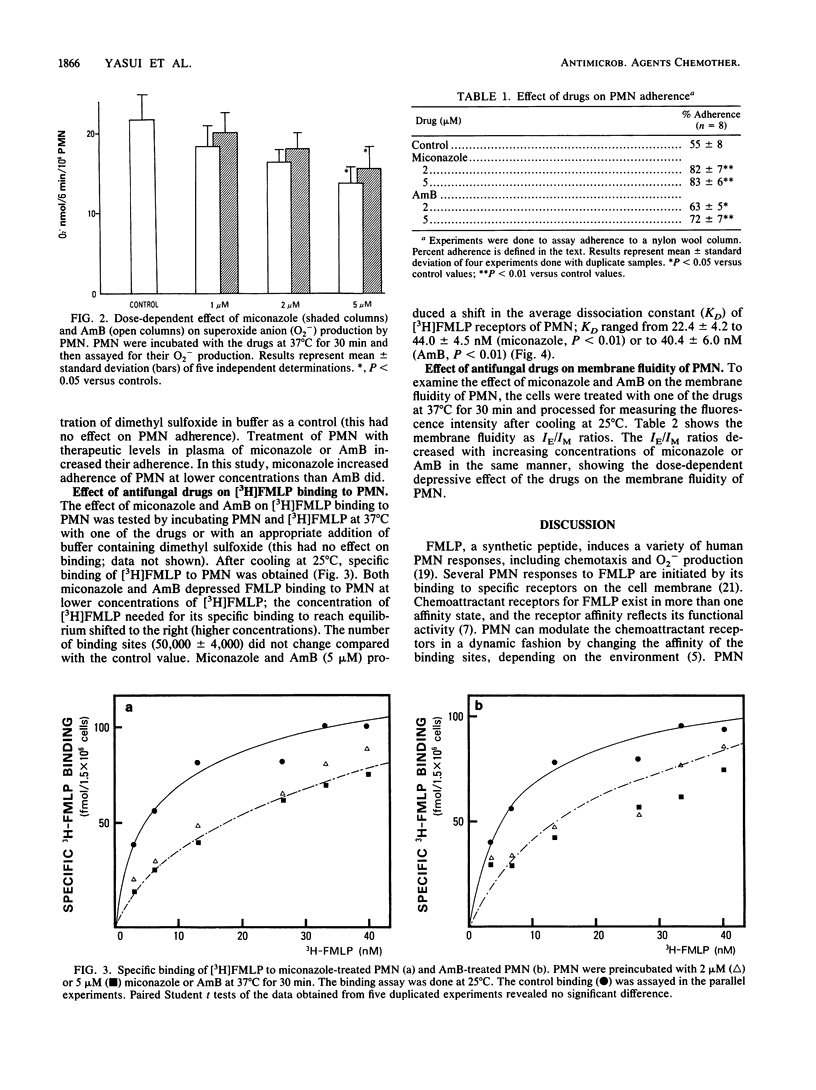
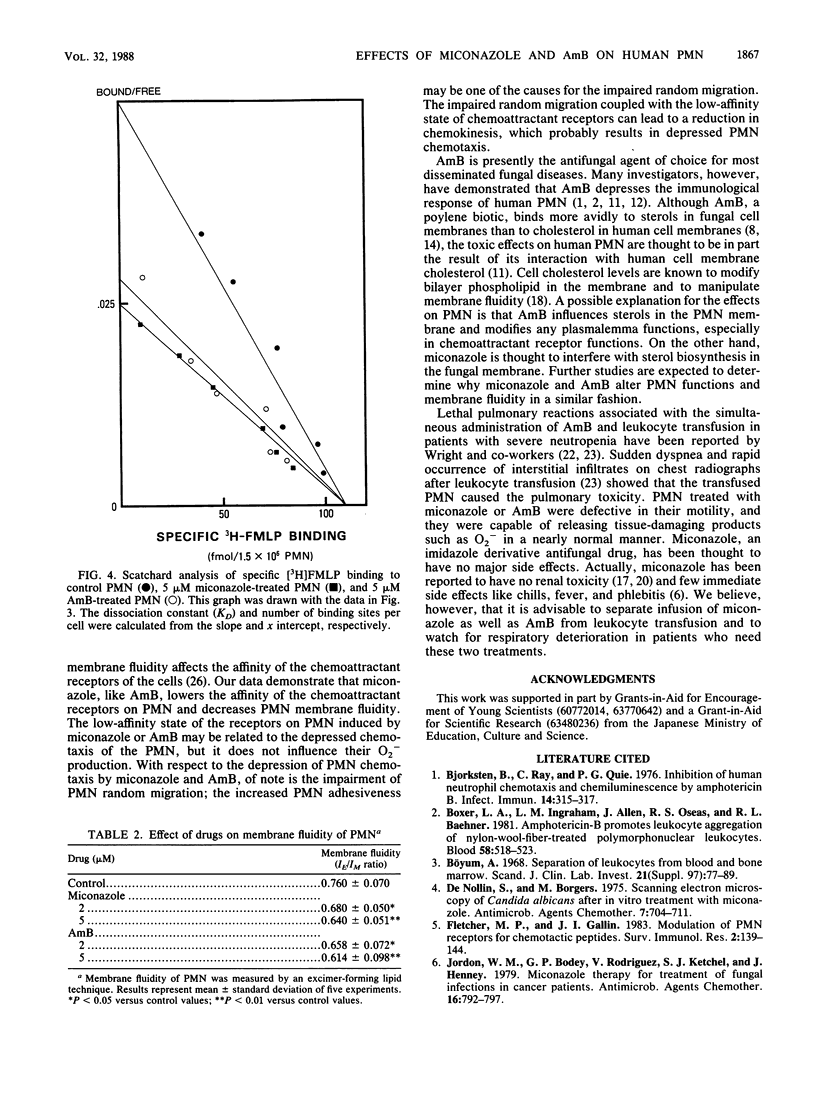
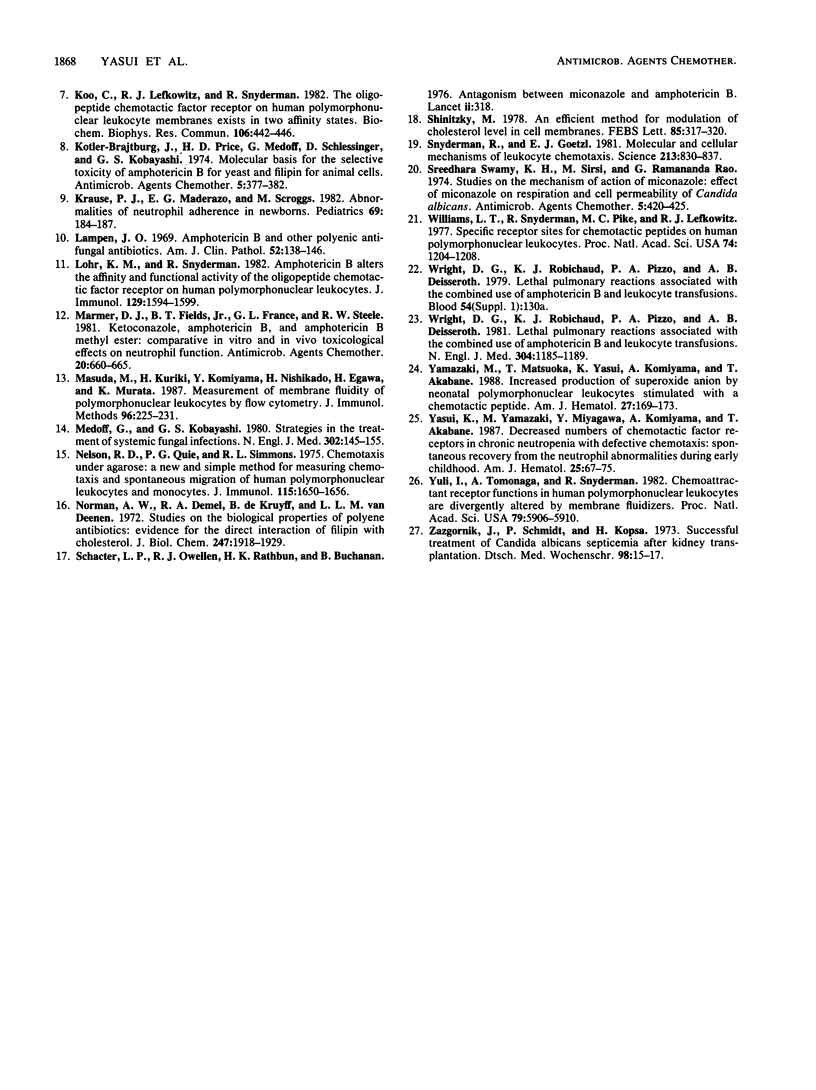
Selected References
These references are in PubMed. This may not be the complete list of references from this article.
- Björkstén B., Ray C., Quie P. G. Inhibition of human neutrophil chemotaxis and chemiluminescence by amphotericin B. Infect Immun. 1976 Jul;14(1):315–317. doi: 10.1128/iai.14.1.315-317.1976. [DOI] [PMC free article] [PubMed] [Google Scholar]
- Boxer L. A., Ingraham L. M., Allen J., Oseas R. S., Baehner R. L. Amphotericin-B promotes leukocyte aggregation of nylon-wool-fiber-treated polymorphonuclear leukocytes. Blood. 1981 Sep;58(3):518–523. [PubMed] [Google Scholar]
- De Nollin S., Borgers M. Scanning electron microscopy of Candida albicans after in vitro treatment with miconazole. Antimicrob Agents Chemother. 1975 May;7(5):704–711. doi: 10.1128/aac.7.5.704. [DOI] [PMC free article] [PubMed] [Google Scholar]
- Fletcher M. P., Gallin J. I. Modulation of PMN receptors for chemotactic peptides. Surv Immunol Res. 1983;2(2):139–144. doi: 10.1007/BF02918572. [DOI] [PubMed] [Google Scholar]
- Jordan W. M., Bodey G. P., Rodriguez V., Ketchel S. J., Henney J. Miconazole therapy for treatment of fungal infections in cancer patients. Antimicrob Agents Chemother. 1979 Dec;16(6):792–797. doi: 10.1128/aac.16.6.792. [DOI] [PMC free article] [PubMed] [Google Scholar]
- Koo C., Lefkowitz R. J., Snyderman R. The oligopeptide chemotactic factor receptor on human polymorphonuclear leukocyte membranes exists in two affinity states. Biochem Biophys Res Commun. 1982 May 31;106(2):442–449. doi: 10.1016/0006-291x(82)91130-5. [DOI] [PubMed] [Google Scholar]
- Kotler-Brajtburg J., Price H. D., Medoff G., Schlessinger D., Kobayashi G. S. Molecular basis for the selective toxicity of amphotericin B for yeast and filipin for animal cells. Antimicrob Agents Chemother. 1974 Apr;5(4):377–382. doi: 10.1128/aac.5.4.377. [DOI] [PMC free article] [PubMed] [Google Scholar]
- Krause P. J., Maderazo E. G., Scroggs M. Abnormalities of neutrophil adherence in newborns. Pediatrics. 1982 Feb;69(2):184–187. [PubMed] [Google Scholar]
- Lampen J. O. Amphotericin B and other polyenic antifungal antibiotics. Am J Clin Pathol. 1969 Aug;52(2):138–146. doi: 10.1093/ajcp/52.2.138. [DOI] [PubMed] [Google Scholar]
- Lohr K. M., Snyderman R. Amphotericin B alters the affinity and functional activity of the oligopeptide chemotactic factor receptor on human polymorphonuclear leukocytes. J Immunol. 1982 Oct;129(4):1594–1599. [PubMed] [Google Scholar]
- Marmer D. J., Fields B. T., Jr, France G. L., Steele R. W. Ketoconazole, amphotericin B, and amphotericin B methyl ester: comparative in vitro and in vivo toxicological effects on neutrophil function. Antimicrob Agents Chemother. 1981 Nov;20(5):660–665. doi: 10.1128/aac.20.5.660. [DOI] [PMC free article] [PubMed] [Google Scholar]
- Masuda M., Kuriki H., Komiyama Y., Nishikado H., Egawa H., Murata K. Measurement of membrane fluidity of polymorphonuclear leukocytes by flow cytometry. J Immunol Methods. 1987 Feb 11;96(2):225–231. doi: 10.1016/0022-1759(87)90318-8. [DOI] [PubMed] [Google Scholar]
- Medoff G., Kobayashi G. S. Strategies in the treatment of systemic fungal infections. N Engl J Med. 1980 Jan 17;302(3):145–155. doi: 10.1056/NEJM198001173020304. [DOI] [PubMed] [Google Scholar]
- Mogensen C. E. The glomerular permeability determined by dextran clearance using Sephadex gel filtration. Scand J Clin Lab Invest. 1968;21(1):77–82. doi: 10.3109/00365516809076979. [DOI] [PubMed] [Google Scholar]
- Nelson R. D., Quie P. G., Simmons R. L. Chemotaxis under agarose: a new and simple method for measuring chemotaxis and spontaneous migration of human polymorphonuclear leukocytes and monocytes. J Immunol. 1975 Dec;115(6):1650–1656. [PubMed] [Google Scholar]
- Norman A. W., Demel R. A., de Kruyff B., van Deenen L. L. Studies on the biological properties of polyene antibiotics. Evidence for the direct interaction of filipin with cholesterol. J Biol Chem. 1972 Mar 25;247(6):1918–1929. [PubMed] [Google Scholar]
- Schacter L. P., Owellen R. J., Rathbun H. K., Buchanan B. Letter: Antagonism between miconazole and amphotericin B. Lancet. 1976 Aug 7;2(7980):318–318. doi: 10.1016/s0140-6736(76)90774-1. [DOI] [PubMed] [Google Scholar]
- Shinitzky M. An efficient method for modulation of cholesterol level in cell membranes. FEBS Lett. 1978 Jan 15;85(2):317–320. doi: 10.1016/0014-5793(78)80482-7. [DOI] [PubMed] [Google Scholar]
- Snyderman R., Goetzl E. J. Molecular and cellular mechanisms of leukocyte chemotaxis. Science. 1981 Aug 21;213(4510):830–837. doi: 10.1126/science.6266014. [DOI] [PubMed] [Google Scholar]
- Sreedhara Swamy K. H., Sirsi M., Ramananda Rao G. R. Studies on the mechanism of action of miconazole: effect of miconazole on respiration and cell permeability of Candida albicans. Antimicrob Agents Chemother. 1974 Apr;5(4):420–425. doi: 10.1128/aac.5.4.420. [DOI] [PMC free article] [PubMed] [Google Scholar]
- Williams L. T., Snyderman R., Pike M. C., Lefkowitz R. J. Specific receptor sites for chemotactic peptides on human polymorphonuclear leukocytes. Proc Natl Acad Sci U S A. 1977 Mar;74(3):1204–1208. doi: 10.1073/pnas.74.3.1204. [DOI] [PMC free article] [PubMed] [Google Scholar]
- Wright D. G., Robichaud K. J., Pizzo P. A., Deisseroth A. B. Lethal pulmonary reactions associated with the combined use of amphotericin B and leukocyte transfusions. N Engl J Med. 1981 May 14;304(20):1185–1189. doi: 10.1056/NEJM198105143042001. [DOI] [PubMed] [Google Scholar]
- Yamazaki M., Matsuoka T., Yasui K., Komiyama A., Akabane T. Increased production of superoxide anion by neonatal polymorphonuclear leukocytes stimulated with a chemotactic peptide. Am J Hematol. 1988 Mar;27(3):169–173. doi: 10.1002/ajh.2830270304. [DOI] [PubMed] [Google Scholar]
- Yasui K., Yamazaki M., Miyagawa Y., Komiyama A., Akabane T. Decreased numbers of chemotactic factor receptors in chronic neutropenia with defective chemotaxis: spontaneous recovery from the neutrophil abnormalities during early childhood. Am J Hematol. 1987 May;25(1):67–75. doi: 10.1002/ajh.2830250107. [DOI] [PubMed] [Google Scholar]
- Yuli I., Tomonaga A., Synderman R. Chemoattractant receptor functions in human polymorphonuclear leukocytes are divergently altered by membrane fluidizers. Proc Natl Acad Sci U S A. 1982 Oct;79(19):5906–5910. doi: 10.1073/pnas.79.19.5906. [DOI] [PMC free article] [PubMed] [Google Scholar]
- Zazgornik J., Schmidt P., Kopsa H., Kotzaurek R. Erfolgreiche Behandlung einer Candida-albicans-sepsis nach Nierentransplantation. Dtsch Med Wochenschr. 1973 Jan 5;98(1):15–17. doi: 10.1055/s-0028-1106737. [DOI] [PubMed] [Google Scholar]


